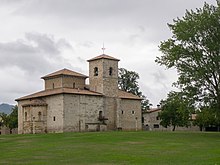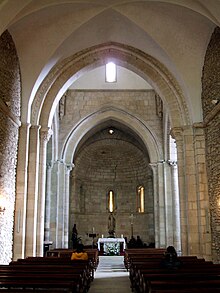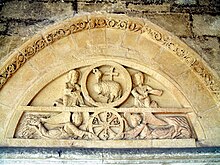San Prudencio
The Basilica of San Prudencio in Armentia is a Romanesque church from the second half of the 12th century, in which a significant part of the original sculptural decoration has been preserved. The church is located on the south-western outskirts of Vitoria-Gasteiz , the capital of the autonomous Spanish region of the Basque Country . In the High Middle Ages , Armentia was the seat of a bishopric for 200 years . In 1931 the church was declared a Monumento Histórico-Artístico de interés nacional ( Bien de Interés Cultural ). The church is used today as a parish church.
history
Armentia was on the Roman road that connected Astorga ( Asturica Augusta ) with Bordeaux ( Burdigala ). Excavations suggest that it was inhabited as early as Roman times . According to legend , St. Prudentius was born here in the 6th century , later mentioned as Bishop of Tarazona and venerated as the patron saint of the province of Álava since 1685 . In the 9th century Armentia was a bishopric until it was moved to Calahorra in 1087 . The Basilica of San Prudencio then became the collegiate church of a canon monastery , which existed until 1498. At that time the canons gave up San Prudencio to settle in Vitoria. The church of Santa María became their new collegiate church, which became a cathedral (today Catedral Vieja ) after the establishment of the diocese of Vitoria in 1862 .
The current church of San Prudencio was built towards the end of the 12th century. It was first dedicated to the apostle Andrew . Between 1773 and 1776 the church underwent major changes. The south facade was torn down and the porch was built. In 1979 the basilica was consecrated to St. Prudentius.
architecture
The church is built from regularly hewn sandstone blocks. Its plan is a Latin cross .
Exterior construction
The semicircular apse is still from the original building from the 12th century. It is divided into three segments by two half-columns , each with a narrow, loopholed window cut into it. The round arches of the window niches rest on capitals with roughly worked figurative scenes, which are interpreted as symbolic representations of human vices or the struggle of good against evil. Fish and lamb are symbols of Christianity. Halfway up there is a cornice with a chessboard frieze . The corbels under the roof approach, on which animals, mythical creatures and human heads are depicted, are much finer than the capitals of the window openings .
inner space
The single-nave nave extends over three bays and is covered with a non-original groin vault. The church has a transept with a later added square crossing tower , a large sanctuary and a semicircular apse.
The arched ribs of the crossing dome rest on corbels on which angels blow horns. The four evangelists stand underneath on consoles decorated with atlases and human heads . Their heads are those of their symbolic beings . Luke has a bull's head, Johannes an eagle's head, Matthew a human head, and Mark a lion's head. The capitals of the columns depict stylized plant motifs and figurative scenes such as horsemen fighting with centaurs , wild animals, monsters devouring people, birds, griffins and lions.
Sculpture fragments in the vestibule
In the 18th century, parts of the church's original sculptural decoration were embedded in the walls of the south porch. In addition to a scene of the Annunciation and an equestrian representation, two tympana of former portals have been preserved. The larger tympanum depicts Christ's ascension to heaven , accompanied by Enoch and Elias and surrounded by eleven apostles and two angels. The smaller tympanum is provided with inscriptions and depicts the Lamb of God between John the Baptist and the prophet Isaiah above the Christ monogram , which is held by two angels . Under this tympanum there is a niche with a sarcophagus behind small stone arcades . Other reliefs date from the 13th century and depict the entombment of Christ with the three Marys and Christ's descent into hell .
Furnishing
A Romanesque font has been preserved in the church .
literature
- Jaime Cobreros: Las Rutas del Románico en España . Volume II, Madrid 2004, ISBN 84-9776-112-X , pp. 310-311.
Web links
- Armentia: Basílica de San Prudencio La guía digital del arte románico (Spanish)
Coordinates: 42 ° 49 '59.2 " N , 2 ° 42' 7.4" W.




